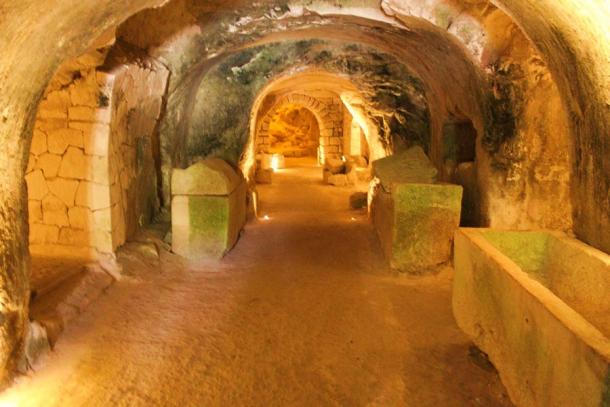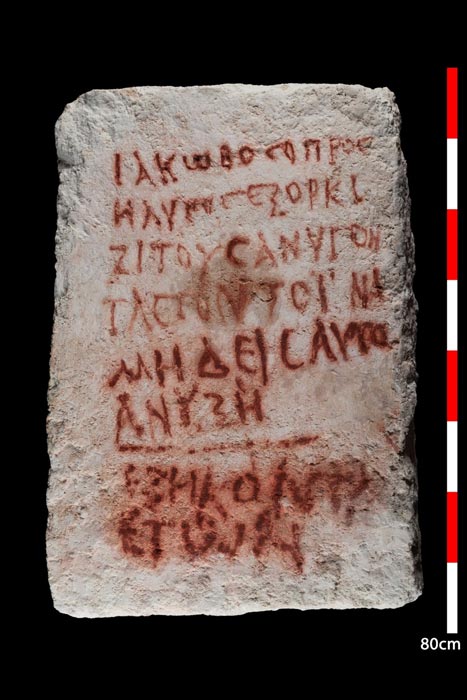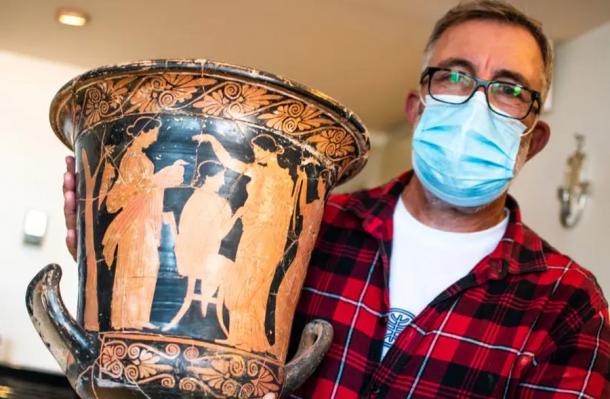Disturbing Red Painted Curse Discovered In Jerusalem Catacomb
An ancient painted curse has been discovered in a tomb in Beit She'arim. Representing the first such discovery in 65 years, the timeworn Greek text warns thieves that Yaakov (Jacob) “the Proselyte” will curse them.
Yaakov lived about 1,800 years ago. His title, “the Proselyte,” means he converted to Judaism. After having died at around 60 years of age Jacob was interred in a cave at Beit She’arim, the ancient Jewish town and necropolis in Lower Galilee during the Roman period. The park-like area around the necropolis is about 100 kilometers or 62 miles northwest of Tel Aviv and has been a UNESCO World Heritage Site since 2015.
After Jerusalem’s destruction in 70 AD the Sanhedrin Jewish council moved to Beit She’arim, and it became the new Jewish center of education and learning. Archaeologists from the Israel Antiquities Authority (IAA) and University of Haifa revealed on Wednesday that the curse was found painted in a catacomb in the Beit She’arim necropolis that was only discovered last year.

Corridor in Catacomb no. 20, "Cave of the Coffins" (Davidbena / CC BY-SA 4.0)
The Red Painted Curse or Hex Was Written in Greek
According to a report in Haaretz, it was Jonathan Price, professor of ancient history at Tel Aviv University, who discovered the two Greek inscriptions inside the innermost chamber of an unexplored tomb. The painted curse, or hex, was written in Greek, in red paint, on a wall near the burial lodge. It was specifically designed to deter grave robbers, and as such it says: “Jacob the Proselyte vows to curse anybody who would open this grave, so nobody will open it. He was 60.”

The curse, written in red paint on stone at an ancient grave in Beit She'arim. It reads “Jacob the Proselyte vows to curse anybody who would open this grave, so nobody will open it. He was 60.” As translated by Jonathan Price, professor of ancient history at Tel Aviv University. (יבגני אוסטרובסקי/IAA)
The researchers suspect his age, 60, was written by someone after Jacob had died. Prof. Adi Erlich of the Zinman Institute of Archeology at the University of Haifa, who leads the excavations at Beit She’arim, said the inscription dates to the Late Roman or Early Byzantine period (i.e. circa 390-400 AD). Prof. Erlich also explains that Jacob, or Yaakov the Proselyte, was probably a Christian, or had belonged to one of the popular cults of Isis or Mithra.
The “Life-changing” Conversion of Jacob To Judaism
What exactly did Jacob have to do to convert to Judaism? Firstly, according to an article in the BBC, converting to Judaism “is not easy” and involves many serious lifestyle changes. After about a year of studying Jewish law converts not only have to wholeheartedly accept the Jewish faith, but they become a member of the Jewish People, and they must embrace the totality of Jewish history, and the culture that grows from it.
- Puzzling Subterranean Chambers Discovered at Jerusalem's Western Wall
- Discoveries Show that Galilee and Jerusalem are Far Older than Once Believed
Even when a prospective candidate's heart is in the right place, the process of conversion to Judaism is governed by Jewish religious law in a religious court. And while many changes must be made in diet and lifestyle, perhaps the hardest is that male converts must undergo circumcision. And even if a man is already circumcised, this is all about ritual, and blood must again be drawn, as the whole ordeal is symbolic of the covenant between God and Abraham described in the Old Testament.
From Ancient to Contemporary Grave Robbers in Israel
Jacob’s curse was aimed directly at tomb robbers over 1,500 years ago, but looting is still a problem in Israel today. In 2012, the Times of Israel reported on a small squad from the Israel Antiquities Authority “who rappelled to the bottom of an ancient well, crawled through a narrow entrance into a 2,000-year-old horizontal tunnel and surprised two Palestinian men scouring the passageway for artifacts.”

A stolen and recovered Greek vase painted in the red-figure style, looted from Israel, with Head of the Anti-Theft Unit at the IAA Amir Ganor. (Yuli Schwartz / IAA)
Only last year Amir Ganor, Head of the Anti-Theft Unit at the IAA, told the Jerusalem Post about “one of the most significant operations undertaken in the history of the country to fight the unlawful trade in artifacts.” A criminal ring had stolen ceramic pottery, coins, jewels and protomas (representation of the head and neck of an animal) of Roman deities “valued at roughly tens of millions of shekels.” Ganor said many of the objects were “left in tombs as offerings to the dead and were meant to serve the departed in the life beyond.”
It seems that as the age of science progresses, curse effectiveness diminishes and grave robbing increases.
Top image: The red painted curse found in a new tomb at UNESCO-listed Beit She'arim, Israel, about 100 km or 62 miles northwest of Tel Aviv, which warns would-be grave robbers that Jacob is watching! Source: IAA
By Ashley Cowie

















